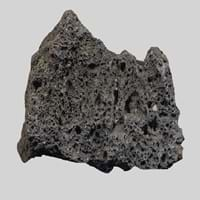Definition
Oolite is a sedimentary rock formed from ooids, spherical grains which are composed of concentric layers of calcite
Scoria is a dark-colored extrusive igneous rock with abundant round bubble-like cavities
Discoverer
Unknown
Unknown
Etymology
From oo- + -lite, after German Oolit. A rock consisting of fine grains of carbonate of lime
From late Middle English (denoting slag from molten metal), from Greek skōria refuse, from skōr dung
Class
Sedimentary Rocks
Igneous Rocks
Sub-Class
Durable Rock, Medium Hardness Rock
Durable Rock, Medium Hardness Rock
Other Categories
Fine Grained Rock, Opaque Rock
Fine Grained Rock, Opaque Rock
Texture
Clastic or Non-Clastic
Vesicular
Color
Black, Blue, Brown, Cream, Green, Grey, Pink, Red, Silver, White, Yellow
Black, Brown, Dark Grey to Black, Red
Durability
Durable
Durable
Scratch Resistant
Yes
Yes
Appearance
Rounded and Rough
Glassy and Vesicular
Interior Uses
Decorative Aggregates, Flooring, Interior Decoration
Decorative Aggregates, Interior Decoration
Exterior Uses
As Building Stone, As Facing Stone, Garden Decoration, Paving Stone
Garden Decoration, Paving Stone
Other Architectural Uses
Not Yet Used
Curbing
Construction Industry
Cement Manufacture, Cobblestones, Landscaping
Cement Manufacture, Construction Aggregate, for Road Aggregate, In landscaping and drainage works
Medical Industry
Not Yet Used
Not Yet Used
Antiquity Uses
Artifacts
Artifacts, Monuments, Sculpture
Commercial Uses
Creating Artwork, Jewelry, Used in aquariums
As a traction material on snow-covered roads, Creating Artwork, High-temperature insulation, In gas barbecue grills
Types
Not Available
Not Available
Features
Available in lots of colors, Generally rough to touch, Very fine grained rock
Available in Lots of Colors and Patterns, Generally rough to touch, Surfaces are often shiny
Archaeological Significance
Monuments
Not Yet Used
Used
Famous Monuments
Not Applicable
Data Not Available
Sculpture
Not Yet Used
Used
Famous Sculptures
Not Applicable
Data Not Available
Figurines
Not Yet Used
Used
Formation
Oolites form when layers of calcite are deposited around a sand grain or fossil piece and are rolled around in calm water, which makes them round.
Scoria forms when magma containing huge amount of dissolved gas flows from a volcano during an eruption.
Mineral Content
Calcite, Chert, Clay, Dolomite, Quartz, Sand, Silt
Apatite, Biotite, Calcite, Feldspar, Hematite, Hornblade, Ilmenite, Magnetite, Olivine, Pyroxene, Quartz, Silica
Compound Content
Aluminium Oxide, Ca, NaCl, CaO, Iron(III) Oxide, FeO, MgO
Ca, NaCl
Types of Metamorphism
Not Applicable
Burial Metamorphism, Cataclastic Metamorphism, Contact Metamorphism
Types of Weathering
Biological Weathering, Chemical Weathering, Mechanical Weathering
Biological Weathering, Chemical Weathering, Mechanical Weathering
Types of Erosion
Chemical Erosion, Coastal Erosion
Chemical Erosion, Coastal Erosion, Glacier Erosion
Grain Size
Fine Grained
Fine Grained
Fracture
Conchoidal
Conchoidal
Porosity
Less Porous
Highly Porous
Luster
Pearly to Shiny
Subvitreous to Dull
Cleavage
Non-Existent
Perfect
Specific Gravity
Not Available
Not Available
Transparency
Opaque
Opaque
Density
Not Available
Not Available
Resistance
Heat Resistant, Wear Resistant
Heat Resistant, Impact Resistant, Pressure Resistant, Wear Resistant
Deposits in Eastern Continents
Asia
Brunei, India, Indonesia, Malaysia, Singapore, Thailand, Vietnam
Afghanistan, Indonesia, Japan, Russia
Africa
Cameroon, Chad, Ghana, Kenya, Malawi, Sudan, Tanzania, Togo, Zambia, Zimbabwe
Ethiopia, Kenya, Tanzania
Europe
United Kingdom
Greece, Hungary, Iceland, Italy, Turkey
Others
Not Yet Found
Not Yet Found
Deposits in Western Continents
North America
USA
Bahamas, Barbados, Canada, Costa Rica, Cuba, Jamaica, Mexico, USA
South America
Colombia
Argentina, Chile, Ecuador, Peru
Deposits in Oceania Continent
Australia
Adelaide, New Zealand, Queensland, Tonga, Victoria, Yorke Peninsula
New Zealand, Western Australia
Oolite vs Scoria Characteristics
Though some rocks look identical, they have certain characteristics which distinguish them from others. Characteristics of rocks include texture, appearance, color, fracture, streak, hardness etc. Oolite vs Scoria characteristics assist us to distinguish and recognize rocks. Also you can check about Properties of Oolite and Properties of Scoria. Learn more about Oolite vs Scoria in the next section. The interior uses of Oolite include Decorative aggregates, Flooring and Interior decoration whereas the interior uses of Scoria include Decorative aggregates and Interior decoration. Due to some exceptional properties of Oolite and Scoria, they have various applications in construction industry. The uses of Oolite in construction industry include Cement manufacture, Cobblestones, Landscaping and that of Scoria include Cement manufacture, Construction aggregate, For road aggregate, In landscaping and drainage works.
More about Oolite and Scoria
Here you can know more about Oolite and Scoria. The life cycle of a rock consists of formation of rock, composition of rock and transformation of rock. The composition of Oolite and Scoria consists of mineral content and compound content. The mineral content of Oolite includes Calcite, Chert, Clay, Dolomite, Quartz, Sand, Silt and mineral content of Scoria includes Apatite, Biotite, Calcite, Feldspar, Hematite, Hornblade, Ilmenite, Magnetite, Olivine, Pyroxene, Quartz, Silica. You can also check out the list of all Sedimentary Rocks. When we have to compare Oolite vs Scoria, the texture, color and appearance plays an important role in determining the type of rock. Oolite is available in black, blue, brown, cream, green, grey, pink, red, silver, white, yellow colors whereas, Scoria is available in black, brown, dark grey to black, red colors. Appearance of Oolite is Rounded and Rough and that of Scoria is Glassy and Vesicular. Properties of rock is another aspect for Oolite vs Scoria. The hardness of Oolite is 3-4 and that of Scoria is 5-6. The types of Oolite are Not Available whereas types of Scoria are Not Available. Streak of rock is the color of powder produced when it is dragged across an unweathered surface. The streak of Oolite and Scoria is white. The specific heat capacity of Oolite is Not Available and that of Scoria is Not Available. Depending on the properties like hardness, toughness, specific heat capacity, porosity etc., rocks are resistant to heat, wear, impact, etc.Oolite is heat resistant, wear resistant whereas Scoria is heat resistant, impact resistant, pressure resistant, wear resistant.





